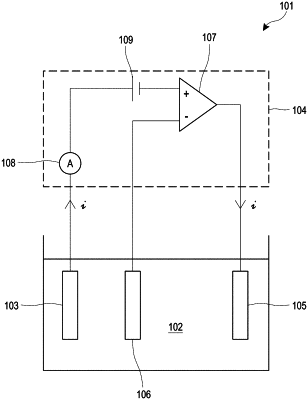| CPC A61B 5/14865 (2013.01) [A61B 5/0031 (2013.01); A61B 5/1473 (2013.01); A61B 5/14532 (2013.01); A61B 5/72 (2013.01); A61B 5/742 (2013.01); B01J 13/0013 (2013.01); B05D 5/00 (2013.01); B05D 5/02 (2013.01); C09D 5/028 (2013.01); C09D 5/24 (2013.01); C09D 7/67 (2018.01); C12Q 1/006 (2013.01); G01N 27/327 (2013.01); G01N 27/3271 (2013.01); G01N 27/3335 (2013.01); G01N 27/4168 (2013.01); G01N 33/49 (2013.01); A61B 5/1486 (2013.01); A61B 2560/0475 (2013.01); A61B 2562/0285 (2013.01); A61B 2562/125 (2013.01); B82Y 15/00 (2013.01); B82Y 30/00 (2013.01); B82Y 40/00 (2013.01); G01N 33/66 (2013.01); G01N 2400/00 (2013.01); Y10S 977/773 (2013.01); Y10S 977/81 (2013.01); Y10S 977/896 (2013.01); Y10S 977/92 (2013.01)] | 31 Claims |

|
1. An apparatus, comprising:
a substrate;
a first electrode comprising a first electrically conductive layer formed over a first electrode location of the substrate and a glucose-oxidation layer formed over the first electrically conductive layer;
a first terminal formed over a first terminal location of the substrate and electrically connected to the first electrode;
a second electrode comprising a second electrically conductive layer formed over a second electrode location of the substrate;
a second terminal formed over a second terminal location of the substrate and electrically connected to the second electrode;
a reference electrode comprising a third electrically conductive layer formed over a reference electrode location of the substrate; and
a third terminal formed over a third terminal location of the substrate and electrically connected to the reference electrode,
wherein, when the first electrode contacts liquid containing glucose and at least one of ascorbic acid and acetaminophen and when applying a first bias voltage between the first and reference electrodes that is sufficient to oxidize glucose in the glucose-oxidation layer, the glucose-oxidation layer of the first electrode is configured to cause oxidation of glucose and at least one of ascorbic acid and acetaminophen therein and further configured to generate a first electric current comprising a glucose component caused by the glucose oxidation and a first interference component caused by oxidation of at least one of ascorbic acid and acetaminophen in the glucose-oxidation layer,
wherein the second electrode is arranged in the apparatus such that, when the first electrode contacts the liquid, the second electrode also contacts the same liquid,
wherein the second electrode does not comprise a layer configured to cause oxidation of glucose therein such that, when applying a second bias voltage between the second and reference electrodes, the second electrode is configured to cause oxidation of at least one of ascorbic acid and acetaminophen therein but not to cause oxidation of glucose therein and further configured to generate a second electric current comprising a second interference component caused by oxidation of at least one of ascorbic acid and acetaminophen in the second electrode and not caused by oxidation of glucose,
wherein the apparatus is configured to provide the first electric current at the first terminal and the second electric current at the second terminal,
wherein the glucose-oxidation layer of the first electrode comprises numerous nanoparticles having a generally oval or spherical shape with a length ranging between about 2 nm and about 5 nm,
wherein the glucose-oxidation layer is substantially free of a surfactant, wherein if any surfactant is contained in the glucose-oxidation layer, the surfactant is in an amount smaller than 0.5 parts by weight with reference to 100 parts by weight of the nanoparticles,
wherein the first electrode does not comprise a glucose-specific enzyme.
|